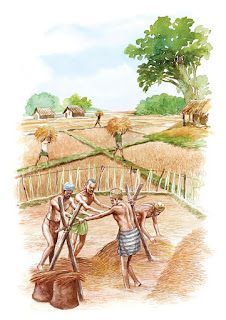History of chena cultivation
Chena cultivation is the oldest cultivation method in sri lanka. Archaeological sources such as "buthsarana" confirms that Chena cultivation is older than mud cultivation. This method is commonly found in the Dry zone of sri lanka. In the past the head of village has allow only a newly married couple to start a chena. The purpose was providing economical , nutritional strength to the new family.
What is a chena cultivation?
In this method a field about 0.4 - 0.8 hectares Is selected and cultivated continuously for several years. Continued cultivation of the land will result in a loss of soil fertile and nutrients. Then people used to cultivate elsewhere. The land transfer scheme is in operation.
Sri lanka's chena cultivation begins in June and July. During this time, a place in the forest is selected and burned. This period is free of rain. Using a leftover unleaded wood,a hedge is laid arround the chena. Large treesare saved by cutting, and a small tree house is made on single tree to protect from wild animals. Mixed crops are cultivated in chena. Cultivate short - term crops such as paddy, kurakkan, maize, puhul, idal, seasame, millet, cowpea, mango, chili, sweet potato etc. After the establishment of the field, farming practises including fertilizer, weed control and farming are relatively few. This reduces the ccost of fertilizer and yields according to the fertility of the soil.
Time table of a chena.
1. Forest cleaning - the 1st week of july and august.
2. Burning the field - Last week of august.
3. Making fense - 1st week of september.
4. Land preparation - 2nd week of september.
5. Seeding / planting - october
6. Harvesting - January to march
Advantages of chena cultivation.
* Lack of required capital
(The cost of inputs is low as there is no chemical fertilizer application)
* There is less pollution due to non-use of agrochemicals.
* Having a mixed croping system yields a balanced diet.
* Family labor can be used.
* Due to the diversification of crops, there is less risk.
* Diseases and insect pets are destroyed as the soil burns.
* There is no need ti irrigate as it only rains.
Disadvantages of chena cultivation
* The yield per unit area is low.
* High yielding advanced seeds are not used.
* Burning destroys benificial soil organisms and soil structure.
* Cause soil erosion and pollution.
* Due to the absence of organic matter in the soil, the physical and chemical properties of the soil destroyed.
*Biodiversity is reduced.
* Land shifting reduses the primary vegetation.






Good... pls follow my blog . www.sinhalenpost.blogspot.com
ReplyDelete